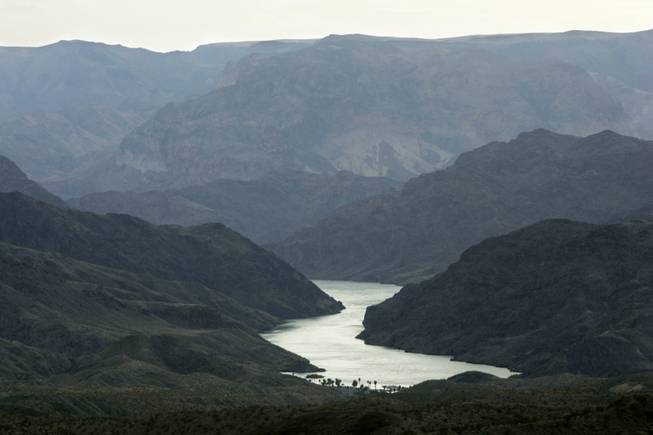
The Colorado River, which is the main source of water for Southern Nevada, winds past Willow Beach, Ariz.
Wednesday, Dec. 12, 2012 | 12:04 p.m.
Future demands on the Colorado River water supply due to projected population growth far outweigh supply, according to a highly anticipated Department of the Interior study released Wednesday.
The report, The Colorado River Basin Water Supply and Demand Study, took three years to complete and analyzes future water supply and demand possibilities based on variables such as projected climate changes climate and varying levels of growth in communities, agriculture and business in the seven Colorado River Basin states – Arizona, California, Colorado, New Mexico, Nevada, Utah and Wyoming.
The study projects water supply and demand imbalances throughout the Colorado River Basin and nearby areas during the next 50 years. The first-of-its-kind study also includes solutions proposed by stakeholders and the public to address projected water shortages.
According to the study, water demand is expected to outweigh supply by more than 3.2 million acre-feet by 2060. One acre-foot of water is approximately the annual amount of water used by a single household. The report, under a rapid-growth scenario, estimates population in the Colorado River Basin, which currently provides water to about 40 million people, could nearly double to about 76.5 million people by 2060.
“There’s no silver bullet to solve the imbalance between the demand for water and the supply in the Colorado River Basin over the next 50 years – rather, it’s going to take diligent planning and collaboration from all stakeholders to identify and move forward with practical solutions,” said U.S. Secretary of Interior Ken Salazar in a statement. “Water is the lifeblood of our communities, and this study provides a solid platform to explore actions we can take toward a sustainable water future. Although not all of the proposals included in the study are feasible, they underscore the broad interest in finding a comprehensive set of solutions."
The study includes more than 150 proposals from study participants, stakeholders and the public that provide a variety of ideas for how to resolve the imbalances. Some people have suggested reuse or desalinization techniques, and reducing demand through increased conservation and efficiency efforts. The report does not include a decision on how future shortages will be addressed.
“This study is one of a number of ongoing basin studies that Reclamation is undertaking through Interior’s WaterSMART Program,” said Anne Castle, assistant secretary for water and science, in a statement. “These analyses pave the way for stakeholders in each basin to come together and determine their own water destiny. This study is a call to action, and we look forward to continuing this collaborative approach as we discuss next steps.”
WaterSMART is the Department of Interior’s sustainable water initiative, which focuses on using the best available science to improve water conservation and help water-resource managers pinpoint strategies to close the gap between supply and demand.
Spanning parts of the seven states, the Colorado River Basin is one of the most critical sources of water in the western United States and northern Mexico. The river once emptied into the Sea of Cortez, but now peters out before ever reaching the once-thriving fishery.
The river and its tributaries provide water to about 40 million people for municipal use and also supply the water used to irrigate approximately 4 million acres of land. At least 22 Native American tribes, seven National Wildlife Refuges, four National Recreation Areas – including the Lake Mead National Recreation Area – and 11 National Parks depend on water from the river.
Numerous groups and organizations, from environmentalists to farmers and small businesses, which all have an interest in how water from the river is distributed and conserved have closely watched the study process and results.
Public comments on the final study will be accepted over the next 90 days, and comments will be summarized and posted to the website for consideration in future basin planning activities.


Join the Discussion:
Check this out for a full explanation of our conversion to the LiveFyre commenting system and instructions on how to sign up for an account.
Full comments policy